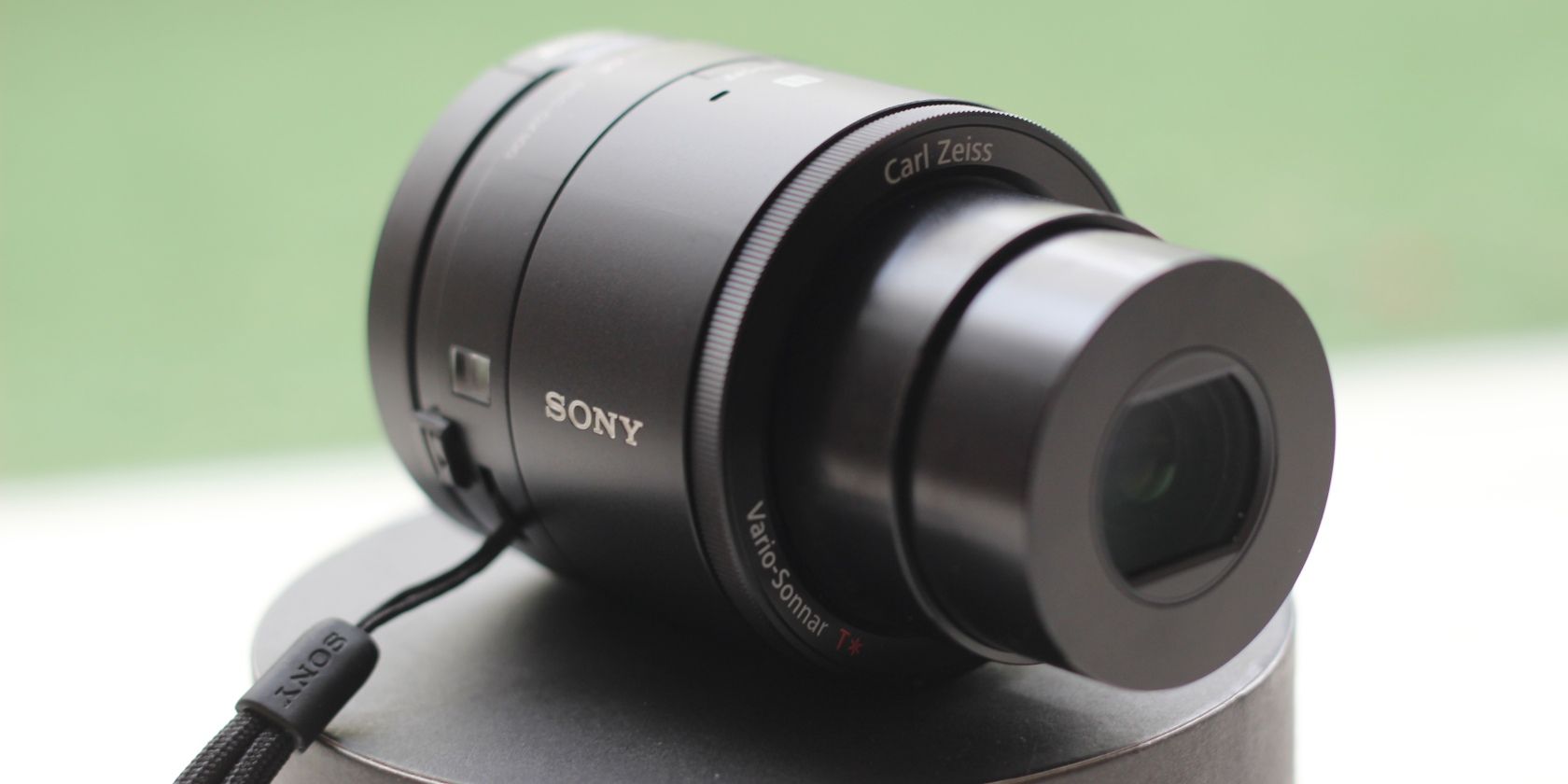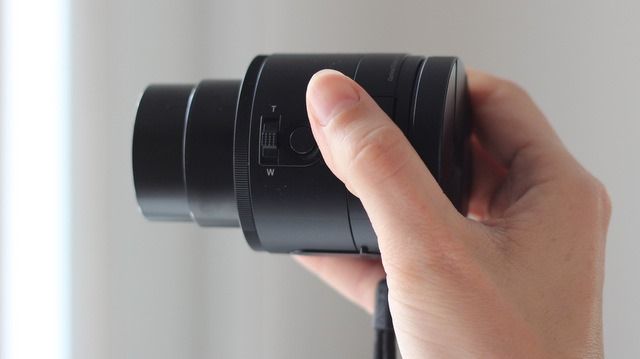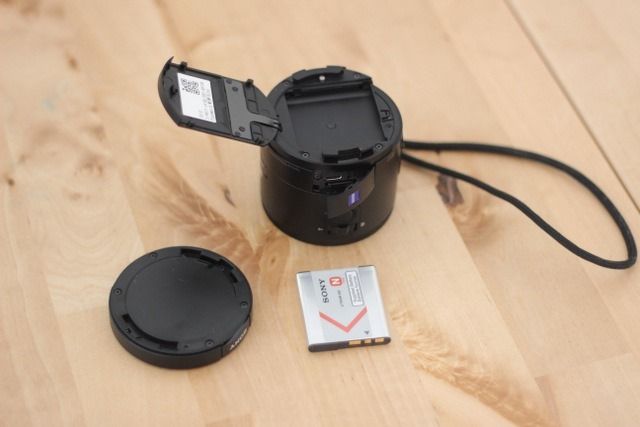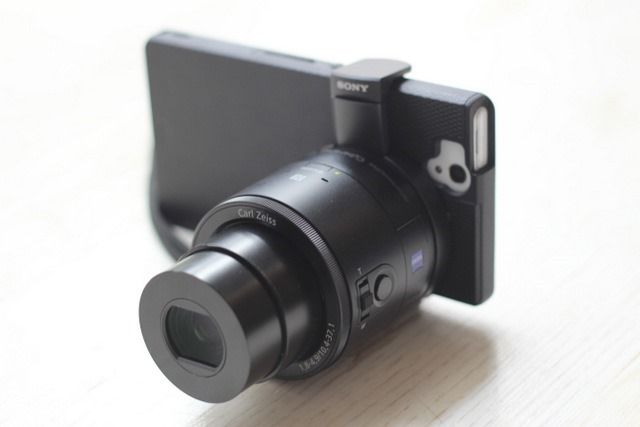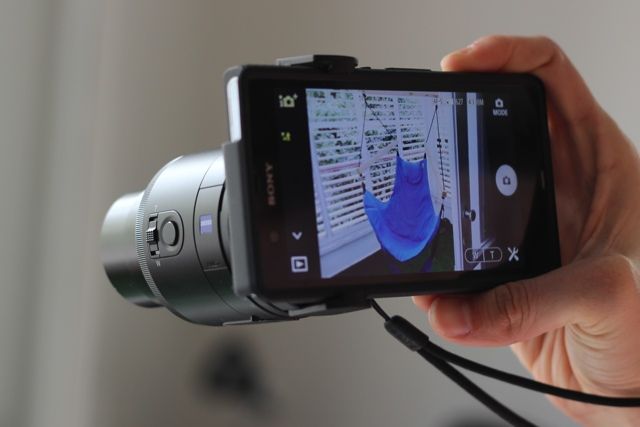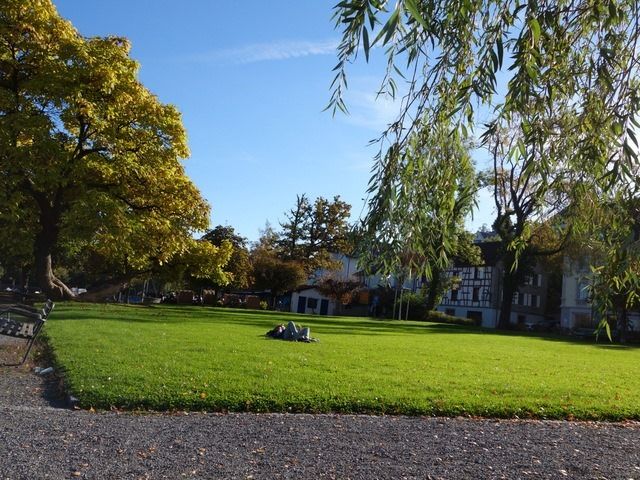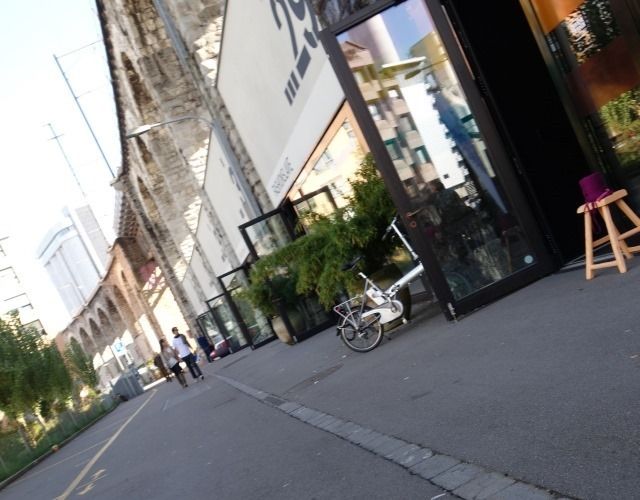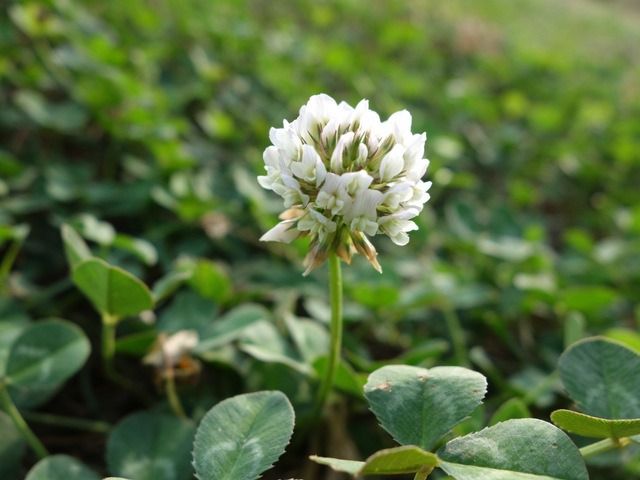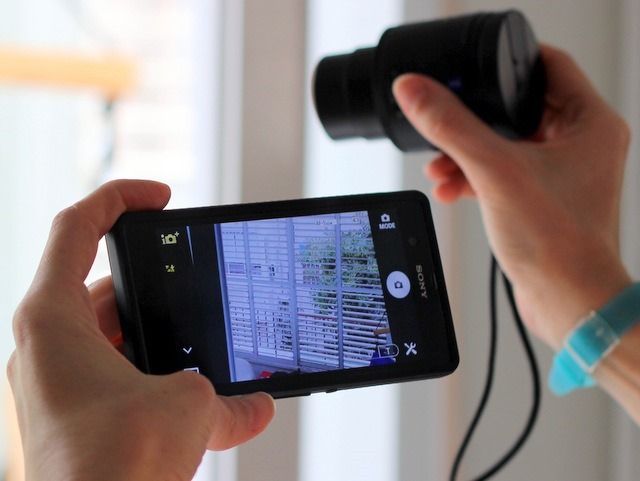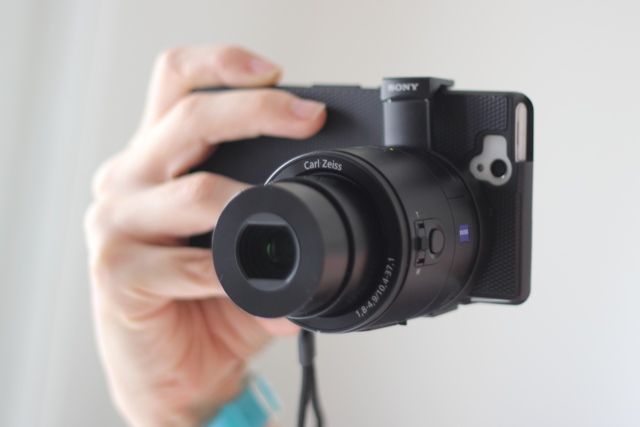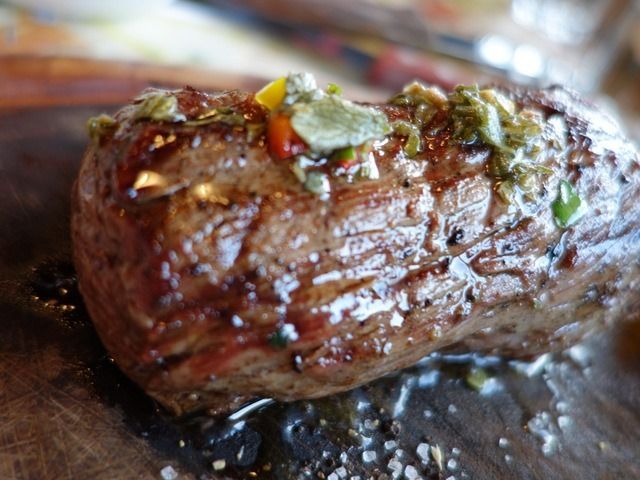Sony DSC-QX100 Smartphone Attachable Lens
How badly do you want to take great photographs? Enough to tote around a dSLR with you wherever you go? While I do know one die-hard photographer who lugs her camera around wherever she goes, most of us lack the dedication. So we're left with the camera that's already in our pocket -- our smartphone. Sadly, most smartphone photos are far from great, at least in terms of raw image quality.
So what's a person to do? Sony thinks it has the answer, in the form of the DSC-QX100. This is $498 camera... without a viewfinder or a screen. It latches onto the screen you carry around anyway (your smartphone), and adds some truly stellar optics for results you could never get using just your smartphone.
We're giving away a Sony DSC-QX100 after this review! So read through, then join the competition to win!
The Competition: Point-And-Shoots
The DSC-QX100 is basically a type of point-and-shoot camera. That's quite literal at times, because it works even if you don't connect it to your phone -- so you can simply point it at something and shoot, without looking through a viewfinder to compose anything.
When it comes to raw specs, the DSC-QX100 packs a 20.2 megapixel Exmor R CMOS sensor, with a Carl Zeiss Vario-Sonnar T lens. The lens is 28-100 mm equivalent, with 3.6x optical zoom, and an F1.8-4.9 aperture and optical image stabilization. It has a MicroSD card slot which also accepts proprietary Sony media (Memory Stick Micro), and built-in Wi-Fi and NFC capabilities it uses to talk to your phone. It weighs 179 grams (0.39 lb.), has a diameter of 63 mm, and is 56 mm tall when closed.
But really, the best way to understand the DSC-QX100 is in the context of its two closest peers in Sony's family of cameras:
- The DSC-RX100M II: This is Sony's excellent point-and-shoot. Stellar image quality, and a price to match: $748.
- The DSC-QX10: This is the DSC-QX100's little brother, retailing for $248. It is noticeably more compact than the DSC-QX100 and offers 10x optical zoom to the DSC-QX100's 3.6x, but is inferior to it in many other ways.
So the DSC-QX100 is right there in the middle, and for a reason: It uses the exact same optics and sensor as the RX100M II. This is good news, being a proven combo that can reliably produce some truly beautiful images. You can look at it as a way of getting the RX100M II's important bits at a saving of $250 -- but it also means it can be clunkier to use.
What's In The Box
The DSC-QX100 doesn't come with many accessories. The nice, circular box contains:
- The camera
- A lanyard attachment (very handy, given its cylindrical, slippery shape)
- A battery
- A smartphone attachment
And that's about it.
Toting The DSC-QX100 Around
Even just carrying the DSC-QX100 around, you can already feel it's all about compromises: It's too big to fit in your pocket, but just carrying it in your hand won't do you much good either. You need to have it connected to your phone in order to see what you're shooting -- so you end up carrying both devices in one hand, with the camera latched onto your phone.
The latching mechanism is composed of two foldable arms with a strong internal spring. Stretch the arms open, stick your smartphone in-between, and they'll firmly grip the camera in place. When connected to a phone, the whole assembly can easily be mistaken for a point-and-shoot camera from the front -- friends were quite surprised to see me pull the camera and phone apart.
Preparing To Snap: Using A Smartphone As A Viewfinder
To use the DSC-QX100, you'll have to pair it with your phone. Before you do that, you'll need to install Sony's PlayMemories Mobile app, which talks to the camera. Then, if your phone is NFC-enabled (as many modern Android phone are), you should be able to simply tap the phone to the camera to automatically pair them.
Unfortunately, this did not work with my own phone, Sony's own Xperia Z -- a phone which is supposed to be perfectly matched with the camera. This may be due to me using an alternative ROM, or perhaps because I'm using a heavy-duty case to protect the phone's fragile glass back. Whatever the reason, to make my phone talk to the camera, I had to resort to the manual pairing option.
This means you switch the phone and camera on, and then you have to key in a password to access the camera. This is a fairly lengthy password, and it's written on the camera's manual (which you may have left at home, or even chucked), as well as on the inside part of the camera's battery cover. So you basically have to pop open the battery cover, enter the password, close it, and pair. This is supposed to be just a one-time thing, and for the most part, it is. The password was forgotten just once, at a very inconvenient moment, making me run through the clunky pairing sequence again and thus missing a shot.
Sort of like a clumsy version of the Transformers.
Clunky is indeed the operative word here: Even once you pair the camera with the phone, they still feel like two different devices attached by a flimsy, slow communication medium (ad-hoc Wi-Fi). This means the live-view often stutters, for example. And if you have a PIN-code set on your phone (as you should), you'll have to key it in every time you switch on the screen to take a photo -- a major annoyance. It's one of those ideas that seem really awesome in advertisements, but end up feeling sort of like a clumsy version of the Transformers in your hand. Taking your first photo requires you to pull the camera out of your bag (because it won't fit in your pocket), turn it on, unfold its legs, snap it onto your phone, turn the phone on, run the PlayMemories app, and finally, wait for it to pair (a process that takes several seconds). Hey, where did that bird go?
To be fair, you can do away with the pairing procedure and just decide to shoot from the hip, assuming you put an SD card in the camera. When you take the phone out of the equation, it's just a matter of switching the camera on, aiming it at something, and clicking the shutter button. Yes, the resulting photos often look just like what you'd be expecting.
Taking The Picture: Terrific Image Quality Fights Timing Woes
Once you have the phone paired with PlayMemories, the fun part starts: You can finally take some pictures. Slight lag notwithstanding, my phone's 5-inch 1080p screen made for a very good viewfinder. PlayMemories offers reasonable control over the camera, including optical zoom and shutter speed (though the camera features hardware buttons for both), and more important, tap-to-focus. You can press any area of the preview image, and the camera immediately brings it into focus. The fast 1.8/f lens (at its widest setting) means you can create satisfyingly narrow depth-of-field on many shots.
After uncomfortably carrying the camera around and enduring the pairing procedure, taking the first photo is like a breath of fresh air. It's truly an a-ha moment -- now you see what it's all about. The DSC-QX100 is no toy: Photos you take with this camera can be virtually indistinguishable from those taken with your average dSLR. The focus is sharp, the colors pop, and the whole thing leaves even the best smartphone cameras miles behind in terms of image quality. With a much bigger lens/sensor combo, it's not even a fair fight -- but that's the point, really.
In terms of composition, the camera's detachable nature opens up some very interesting options. The Wi-Fi data connection doesn't require the camera to be touching the phone, so you can dismantle the two while keeping the software paired. You can then hold the phone at a comfortable, steady viewing angle, while waving the camera around, pivoting it, putting it right on the ground, and exploring all sorts of vantage points from which you would not normally be able to view the screen. This disconnection between screen and lens is a strange feeling at first -- composing takes some getting used to -- but it works.
What doesn't work quite so well is timing. If you're used to the immediacy of a dSLR when capturing action shots, prepare to be disappointed: The Wi-Fi connectivity simply does not allow for such a low lag. There's a very slight lag between the action and what you see on the screen, and then another tiny lag between pressing the shutter button on the screen and the moment the camera snaps the photo. These two lags are enough to spoil many action shots. The camera's built-in shutter button helps, in that it snaps the photo immediately -- but you still have to look at the screen to see what you're shooting, so that lag isn't entirely eliminated.
Another thing that can be quite important to some shutterbugs is that there is no flash on the DSC-QX100, nor does it interface with your phone's built-in flash. The fast lens makes up for it in most indoor situations, and flash shots most often look terribly washed-out and unattractive anyway, but that's one thing to note. Not a serious disadvantage in my opinion (I hardly ever use the flash on my Canon 600D).
Sharing is Caring: Made For Food Porn
You can decide what the DSC-QX100 does once you snap the photo: It can keep the photo on its internal microSD card and move on, but it can also copy a 2 MB "preview image" to your phone, and even copy the entire full-resolution image. While that latter option is not very practical, copying the preview image to your phone works very well, and is one of the strongest selling points for the DSC-QX100. Copying takes about two seconds, and you find yourself looking at a shot that was very obviously not taken with a smartphone, even if the subject is something as mundane as a cup of coffee.
From there, you can use whichever app on your phone to edit the image, and of course, share it with the world. Once the image is on your phone, the DSC-QX100 steps out of the picture -- you can Instagram as usual, only with far, far better photos than you would otherwise have. In practice, it feels kind of like having a super-camera on your smartphone. The photos were not too large to edit with Snapseed, and being able to instantly share them with friends definitely added to the experience.
I did get some puzzled looks, but mainly because the whole scene looked like I was inspecting my steak with a tricorder.
We all know that Instagram was actually made for taking photos of food (right?), and this is another place where the camera's compact nature and odd form factor comes in handy: You can detach it from your phone and hold it right up against your dish without it looking like you're taking a photo of your food. Mind you, I did get some puzzled looks, but mainly because I took my time and the whole scene looked like I was inspecting my steak with a tricorder.
A Compromise Few Photographers Could Truly Love
The DSC-QX100 is a complex device, and not just in terms of specs. It pits cutting-edge optics and a truly connected experience against lag and clunky ergonomics. It is a truly bold and innovative attempt by Sony, and is unlike any other camera I've used before. Sadly, blazing its own experimental path also means the DSC-QX100 sometimes stumbles.
While I must applaud Sony for its adventurous spirit, I would be hard pressed to recommend the DSC-QX100 as an everyday device. It makes for a neat showpiece, for sure, but it is one of those products that seem much more tempting in a TV commercial than when you're fumbling around with it trying to snap a quick picture of your kid.
[recommend]Do not buy. save up just a little bit more, and go with the universally celebrated RX100M II.[/recommend]

